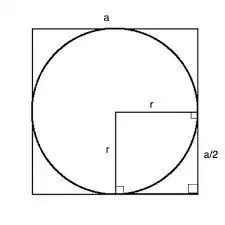When we had the circle in math (a while ago) our math teacher said we should try to find a way to calculate the area of a circle. My friend and I came up with a way to do this: you had to square $d$ and then multiply it with an universal number to get the area of the circle. $$A=d^2\cdot x$$
Our first idea to get the number was by weighing the square $d^2$(for example as a wooden plate) and then cut a circle out, which you had to weigh too. These numbers had to be divided to get the 'universal number'. After that, our teacher told us the formula to calculate the area of a circle, which was $A=r^2\pi$.
Later on I tried to get the number by dividing $ r^2\pi$ (which is the exact area of a circle) with $d^2$. The result was an irrational number: $$x\approx 0.785398$$
Someday I realized that this number was a fourth of pi! That's the back story, my question is now:
Why is $x=\frac{\pi}{4}$
